Types of Objectives
There are three types of objectives:
- Cognitive
- Affective
- Psychomotor
Cognitive Objectives

Cognitive objectives are designed to increase an individual's knowledge. Cognitive objectives relate to understandings, awareness, insights (e.g., "Given a description of a planet, the student will be able to identify that planet, as demonstrated verbally or in writing, with 100% accuracy." or "The student will be able to evaluate two different theories of the origin of the solar system as demonstrated by his/her ability to compare and discuss verbally or in writing the strengths and weaknesses of each theory."). This includes knowledge or information recall, comprehension or conceptual understanding, the ability to apply knowledge, the ability to analyze a situation, the ability to synthesize information from a given situation, the ability to evaluate a given situation, and the ability to create something new.
Affective Objectives

Affective objectives are designed to change an individual's attitude. Affective objectives refer to attitudes, appreciations, and relationships (e.g., "Given the opportunity to work in a team with several people of different races, the student will demonstrate an positive increase in attitude towards non-discrimination of race, as measured by a checklist utilized/completed by non-team members.").
Psychomotor Objectives

Psychomotor objectives are designed to build a physical skill (e.g., "The student will be able to ride a two-wheel bicycle on a flat road surface without assistance and without pause for 10 seconds without falling as demonstrated in gym class."); actions that demonstrate the fine motor skills such as use of precision instruments or tools, or actions that evidence gross motor skills such as the use of the body in dance or athletic performance.